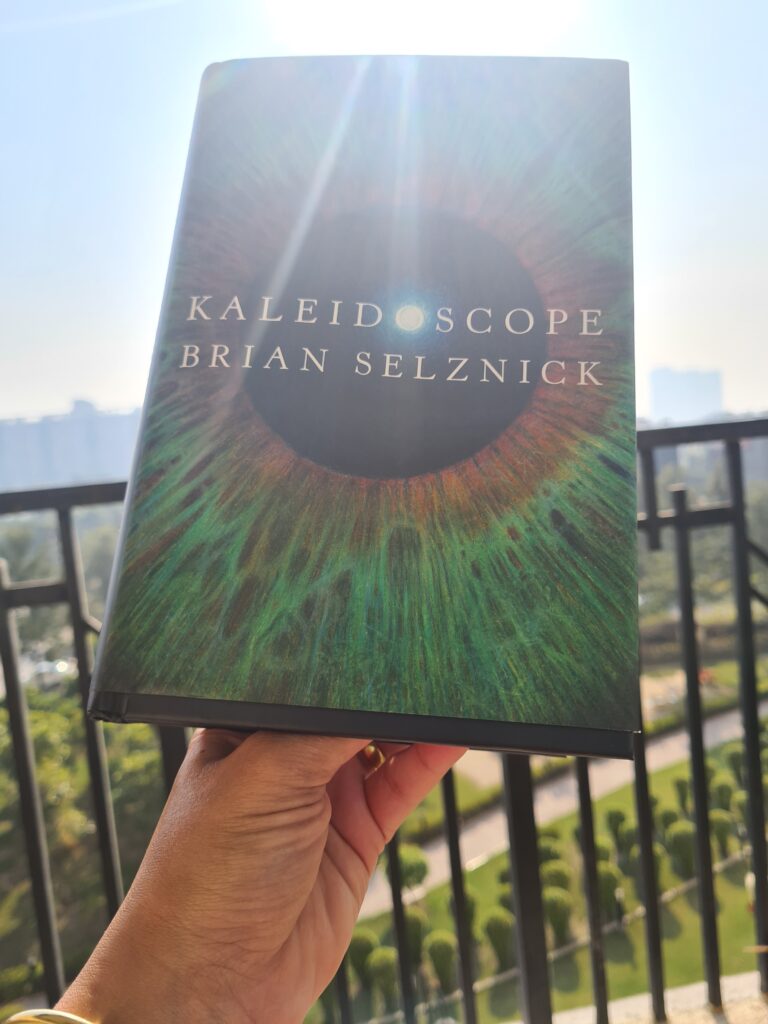Brian Selznick’s “Kaleidoscope”

Many people didn’t understand what it was, and many thought that you had taken your sadness and loss and made something beautiful out of it. You met artists, scientists, and dreamers, and you engaged in long conevrsations and exchanged fascinating letters with authors and philosophers for years afterward. In a way, I believe it saved your life . . . and if you want to know a secret, that’s why I gave you the dream in the first place.
….
We had only a tiny fraction of everything he wrote in our possession, but the fragments included references to Greek myths, the origins of the universe, children’s fantasy novels, the quests of King Arthur’s knights, the creation of the periodic table, a man who found the entrance to a buried city behind a wall in his house, spaceships, ancient Egypt, mysterious castles, the invention of the kaleidoscope, and the knitted blankets of his childhood bed.
…
“Didn’t you have something you wanted to tell me?”
“Yes, I’ve been trying all night to tell you,” said the bat. “But you wouldn’t stop fighting me. It was very annoying. And now I have to go.”
A sudden, strange kind of shame came over me. “I;m sorry,” I said. “What were you trying to tell me?”
The little creature stretched his spiky wings. His eyes sparkled. “I’ve been trying to tell you I love you,” he said, and with a little leap he vanished into the purple Connecticut sky.
…
In bed as I close my eyes, I wonder if the beginning of time and the end of time are the same thing, and the distance between seconds is really as long as the distance between stars. Maybe this is what it’s like to be inside the mind of God. The past and the future mean nothing, and the time is always now.
Brian Selznick’s latest book, Kaleidoscope, is an extraordinary feat of storytelling (Scholastic). The author calls it a mysteyr that takes place in the space of a day but seems to be spread over two thousand years. It is about two individuals connected to each other across time and space — the narrator and his friend James. Yet, the micro-stories in the volume use a bunch of personal pronouns that can easily replace the characters with the reader/s. The stories shimmer. There are stories about a shipwreck, journeys, libraries, writers, butterflies, artists, magical creatures, angels, guardians, giants, etc. These are magical stories that can possibly be read in any sequence without disrupting the sheer pleasure of the vast imaginative landscape. The New York Times refers to it as a ‘lockdown masterpiece‘ ( 17 Sept 2021). Rightly so. The book provides oodles of hope, joy, and love for the future; it also builds upon a post-Edenic creation of society by its play on the apple — a real fruit and a metaphor. Much like what many are experiencing about a post-pandemic world, life before the covid crisis seemed idyllic, like paradise, and it has been completely disrupted. The collection of stories are a mix of traditions, references, and with it a lot of originality. It is ultimately in the hands of the reader to decide how to approach these stories and tease out the beauty and aestheticism enshrined in them, much like the ordinary pieces of coloured glass in a kaleidoscope become a burst of beautiful, intricate patterns dependant on how the person holding the instrument chooses to move it. As with the stories, life too is about a series of choices and it is upto the individual to make the best of one’s circumstances — to be worried and anxious about the pandemic or live life with joy each day. It is about free will. Accompanying the stories are the gorgeous illustrations in graphite by Brian Selznick. Flipping through the images, they have a parallel story to tell but can also illuminate the text very well too. Every story has a full page illustration but tipped in between the stories are double-page spreads of kaleidoscope patterns.
Kaleidoscope is a stupendous book that is meant not only for teenagers but for everyone. It should be marketed in such a manner. It can easily straddle the genres of fiction, children’s literature, young adult literature and mind, body, spirit books. It is about taking a journey and understanding one’s own free will. It provides hope, succour, companionship and a sense of belonging, especially during the pandemic, when everyone is feeling so adrift and lost.
Kaleidoscope is a masterpiece. Buy it. Treasure it. Gift it.
6 Feb 2022

